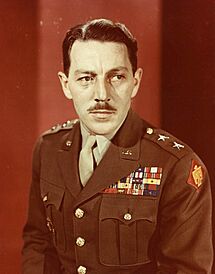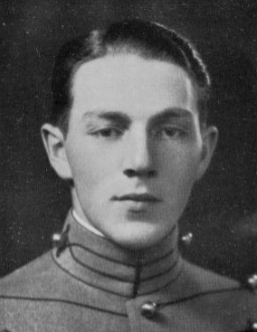Robert T. Frederick facts for kids
Quick facts for kids
Robert T. Frederick
|
|
|---|---|
 |
|
| Born | March 14, 1907 San Francisco, California, U.S. |
| Died | November 29, 1970 (aged 63) Stanford, California, U.S. |
| Allegiance | United States |
| Service/ |
United States Army |
| Years of service | 1928–1952 |
| Rank | Major General |
| Service number | O-17196 |
| Unit | Coastal Artillery Corps |
| Commands held | 1st Special Service Force 1st Allied Airborne Task Force 45th Infantry Division 4th Infantry Division 6th Infantry Division |
| Battles/wars | World War II |
| Awards | Distinguished Service Cross (2) Army Distinguished Service Medal (2) Silver Star Legion of Merit (2) Bronze Star Medal (2) Purple Heart (8) |
Major General Robert Tryon Frederick (born March 14, 1907 – died November 29, 1970) was a very important U.S. Army officer. During World War II, he led special forces and large groups of soldiers. He was known for his bravery and was given the Distinguished Service Cross twice for his actions in battle.
Contents
Early Life and Military Training
Robert Frederick was born in San Francisco, California, on March 14, 1907. He went to a military school called Staunton Military Academy. Later, he attended the United States Military Academy (USMA) at West Point, New York, which is a famous school for training army officers.
After graduating in 1928, he became a second lieutenant in the Coast Artillery Corps. This part of the army was in charge of defending coastlines. He also went to the U.S. Army Command and General Staff College in 1939, where officers learn how to lead larger groups of soldiers.
Leading in World War II
When the United States joined World War II after the attack on Pearl Harbor, Frederick was working in the War Department. In 1942, he was a lieutenant colonel. He was given a big job: to create a new special commando unit. This unit was made up of soldiers from both the U.S. and Canada.
The Devil's Brigade
This new unit became known as the 1st Special Service Force. Later, the Germans called them the "Devil's Brigade" because they were so tough. The unit started on July 9, 1942, in Montana. They trained very hard for fighting in winter and mountains. They also learned hand-to-hand combat and other important soldier skills.
At first, they were supposed to go to Norway, but that plan changed. In 1943, they were sent to the Aleutian Islands. Then, in October 1943, they went to Europe to join the war there.
Fighting in Italy
Frederick's soldiers arrived in Casablanca in November 1943. They quickly moved to the Italian front. They landed in Naples and immediately went into battle. In late 1943 and early 1944, the 1st Special Service Force fought in tough mountain battles. They bravely attacked and captured a strong enemy position called Monte la Difensa.
On February 2, 1944, Frederick, who was now a full colonel, and his men landed at Anzio. They were the first Allied troops to enter Rome, the capital of Italy, on June 4, 1944.
Frederick was honored twice with the Distinguished Service Cross. This is the second-highest award for bravery in the U.S. Army. He earned the first for his actions in January 1944, where he was wounded three times. The second award was for his leadership during the push into Rome. While fighting at Anzio, he was wounded many times, even twice in one day!
Leading Airborne Forces
On June 23, 1944, Frederick left the 1st Special Service Force. In July, he was promoted to brigadier general, a one-star general. He was then given command of the 1st Allied Airborne Task Force. This was a large group of airborne soldiers put together for the Allied invasion of Southern France.
On August 15, his unit jumped out of planes behind enemy lines. Their mission was to stop German forces from reaching the beaches where other Allied troops were landing. They succeeded and then moved along the French Riviera coastline. They captured Cannes without a fight and met up with Frederick's old unit, the 1st Special Service Force. The task force continued fighting towards the French-Italian border.
Commanding a Division
At just 37 years old, Frederick was promoted again to major general, a two-star rank. On December 3, 1944, he took command of the 45th Infantry Division. This made him one of the youngest division commanders in the U.S. Army during the war.
His division fought very hard in French Alsace from December 1944 to February 1945. They then joined the final push into Germany. The 45th Division crossed the Rhine River and advanced into Bavaria. They fought in tough battles in Aschaffenburg and Nuremberg. On April 26, they crossed the Danube River, opening the way for other U.S. forces to reach Munich. By April 29, they were in Munich, shifting from fighting to occupying the area.
The British Prime Minister, Sir Winston Churchill, greatly admired Frederick. He called him "the greatest fighting general of all time." Churchill even said that if they had more generals like Frederick, they would have defeated Hitler much sooner.
After World War II
After the war, Frederick's 45th Infantry Division returned to the United States. He gave up command in September 1945. For a while, he was in charge of the Coast Artillery School. He was wounded eight times during the war, so he took some time to recover.
Later, he was assigned to Allied forces in Austria. He commanded the U.S. part of the Vienna Inter-Allied Command in 1948. From 1949 to 1950, he commanded the 4th Infantry Division. Then, from 1950 to 1951, he led the 6th Infantry Division.
In 1951, Frederick went back to Europe to lead the Joint U.S. Military Aid Group, Greece. He retired from the army in March 1952 due to his injuries. In a 1968 movie called The Devil's Brigade, which was about his special unit, actor William Holden played Robert T. Frederick. Frederick passed away on November 29, 1970, in Stanford, California.
The V-42 Combat Knife
The V-42 combat knife was partly designed by Robert Frederick himself. This happened when he was leading the 1st Special Service Force. The V-42 was a special knife that became a symbol for his unit. His soldiers trained a lot to use it. It's a short, thin knife with a special thumb groove on top of the blade. This groove helps soldiers hold the knife correctly when fighting.
The V-42 knife is so important that its shape is part of the badges for the U.S. Army Special Forces and Canada's Joint Task Force Two.
Military Awards and Honors
Robert Frederick received many awards for his brave service. Here are some of his military decorations:
|
|
|||
| 1st Row | Distinguished Service Cross with Oak Leaf Cluster (meaning he received it twice) | Army Distinguished Service Medal with Oak Leaf Cluster (meaning he received it twice) | Silver Star | |||||||||||||||
|---|---|---|---|---|---|---|---|---|---|---|---|---|---|---|---|---|---|---|
| 2nd Row | Legion of Merit with Oak Leaf Cluster (meaning he received it twice) | Bronze Star Medal with Oak Leaf Cluster (meaning he received it twice) | Air Medal | Purple Heart with seven Oak Leaf Clusters (meaning he was wounded eight times) | ||||||||||||||
| 3rd Row | American Defense Service Medal with battle clasp | American Campaign Medal | Asiatic-Pacific Campaign Medal with one service star and Arrowhead device | European-African-Middle Eastern Campaign Medal with three service stars | ||||||||||||||
| 4th Row | World War II Victory Medal | Army of Occupation Medal | National Defense Service Medal | Distinguished Service Order (from the United Kingdom) | ||||||||||||||
| 5th Row | Officer of the Legion of Honour (from France) | Croix de guerre 1939–1945 with palm (from France) | Grand Officer of the Order of St. Charles (from Monaco) | King Haakon VII Freedom Medal (from Norway) | ||||||||||||||



